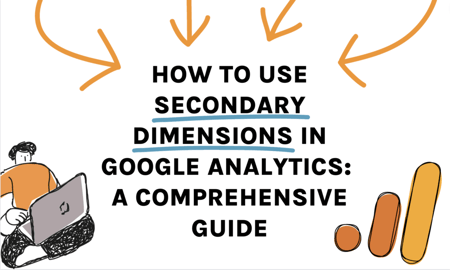Enhance Your Information Analysis Utilizing Second Dimensions
The real depth of insights exists in the assimilation of additional dimensions. The strategic usage of additional measurements elevates evaluation beyond the surface area degree, guaranteeing a wealth of untapped possible waiting to be uncovered.
Comprehending Secondary Measurements
Additional dimensions in data evaluation refer to extra features or metrics that give much deeper understandings when combined with main information measurements, enhancing the general understanding of the dataset. These added measurements provide an even more extensive view of the data, allowing experts to reveal hidden patterns, connections, and fads that might not be obvious when just taking into consideration key measurements.
By integrating additional dimensions into information evaluation, experts can gain a more nuanced understanding of the elements affecting the key metrics. In advertising and marketing evaluation, key dimensions might consist of basic client demographics like age and sex, while secondary measurements can include variables such as buying habits, preferences, or geographic location. By combining these secondary and main measurements, experts can create a lot more thorough client accounts, enabling even more targeted and effective marketing methods.
In addition, secondary dimensions can assist in determining relationships in between different variables, resulting in more exact predictive modeling and decision-making. They allow experts to discover data from multiple viewpoints, improving the understandings attracted from the dataset and inevitably boosting the top quality of evaluation and strategic suggestions.
Advantages of Secondary Dimensions
When thinking about information evaluation, including second measurements uses a plethora of benefits that dramatically boost the deepness and breadth of understandings acquired from key information measurements. By including second measurements such as time, area, or group details to the evaluation, scientists can get a much more detailed understanding of the main data points.
Additionally, second measurements can additionally assist in segmenting data, permitting a much more thorough analysis of particular parts within the key data. This segmentation can result in even more targeted strategies and activities based upon the one-of-a-kind features of each segment. Furthermore, additional dimensions can aid in confirming searchings for from main information measurements, giving a much more robust and trustworthy basis for decision-making.
Essentially, the benefits of incorporating additional measurements into information evaluation are indispensable, supplying richer insights and allowing even more educated decision-making procedures.
Carrying Out Second Dimensions Effectively
Reliable implementation of secondary dimensions in data evaluation requires a tactical approach that optimizes the utility of extra contextual info. When including second dimensions, it is important to straighten them with the primary dimensions to acquire much deeper understandings right into the information. Start by plainly defining the purposes of the evaluation to determine which secondary dimensions will supply one of the most pertinent context. It is important to choose second dimensions that match the key data without creating sound or complication in the evaluation.
Additionally, think about the scalability of the second measurements across different datasets or analyses. Guarantee that the chosen secondary measurements can be continually used and translated throughout different circumstances to preserve the honesty and uniformity of the evaluation. Establish a methodical process for integrating secondary dimensions into the evaluation process to streamline the analysis of results. By executing second measurements efficiently, experts can improve the deepness and precision of their data evaluation, resulting in even more educated decision-making and workable insights.
Advanced Techniques With Additional Measurements
For a much more innovative technique to information evaluation, including additional measurements can significantly elevate the deepness of understandings gotten. Advanced strategies with additional dimensions include more detailed approaches to extract important info from data collections. One such method is accomplice analysis, where information is fractional based upon certain attributes or habits to track patterns in time. This method enables for a much deeper understanding of just how various groups develop and communicate with your product or my blog solution.
One more sophisticated strategy is regression analysis, which aids recognize connections in between variables and just how they affect each various other. By including second dimensions, such as group information or customer behavior, to regression versions, you can uncover more nuanced understandings and make even more accurate predictions.

Study: Secondary Measurements in Action

In one more scenario, a doctor leveraged secondary dimensions to enhance source allowance. By examining client end results in connection with geographical place, the organization determined areas with high readmission rates. This caused the application of targeted treatment programs in those areas, ultimately boosting person treatment and decreasing healthcare prices.
These situation research studies show the power of additional dimensions in discovering beneficial understandings that drive strategic decision-making. By diving deeper into data evaluation past key metrics, companies can obtain an extra thorough understanding of their consumers and operations, resulting in more efficient and informed business approaches.
Final Thought
To conclude, the consolidation of additional measurements in information analysis is vital for gaining a detailed understanding of underlying fads and variables. By using techniques such as cohort analysis and regression analysis, navigate to this website companies can reveal covert insights and make even more informed choices. Secondary measurements include depth and breadth to information evaluation, allowing services to explore information from several viewpoints and drive more reliable end results.
In advertising analysis, main measurements can include fundamental customer demographics like age and sex, while additional dimensions might incorporate variables such as acquiring actions, preferences, or geographical place.When thinking about data analysis, integrating additional dimensions supplies a wide range of benefits that substantially boost the depth and breadth of understandings acquired from key data dimensions.Furthermore, second measurements can additionally help in segmenting data, allowing for an extra detailed evaluation of click to read more certain parts within the primary data. Furthermore, second dimensions can help in confirming searchings for from key data dimensions, giving a more trusted and durable basis for decision-making.
When incorporating secondary dimensions, it is crucial to straighten them with the main dimensions to gain deeper insights right into the data.